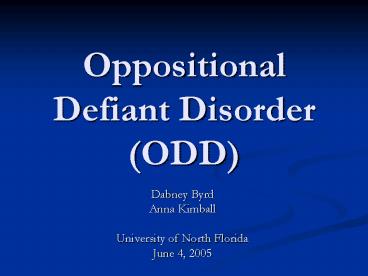Oppositional Defiant Disorder ODD PowerPoint PPT Presentation
1 / 10
Title: Oppositional Defiant Disorder ODD
1
Oppositional Defiant Disorder (ODD)
- Dabney Byrd
- Anna Kimball
- University of North Florida
- June 4, 2005
2
Occupational Defiant Disorder (ODD)
- According to the DSM-IV-TR, children with
occupational defiant disorder display an
age-inappropriate pattern of stubborn hostile,
and defiant behaviors that is persistent and
might be exhibited as early as preschool or
kindergarten. - At least four percent of
- children and adolescence
- are diagnosed with ODD.
3
History of ODD
- Relatively new disorder
- First confirmed as a psychiatric disorder in the
DSM in 1980 as Oppositional Disorder. - Was changed in the DSM-III-R in 1987 to
Oppositional Defiant Disorder.
4
Diagnosis of ODD
- Doctors, psychiatrists, psychologists,
- anyone who has a certified mental health
license, or a licensed counseling social worker. - Children must meet four of the eight behaviors
over the course of six months in the DSM check
list. - Severity of the symptoms and the age of the
client or student is an important part of the
diagnostic criteria.
5
Diagnosis of ODD cont.
- Limitations Internal psychiatric dysfunction or
- a reaction to a negative environment.
- Males are diagnosed at higher rates than females.
6
Other factors to consider
- Developmental Age
- Academic Evaluation
- Total Environment
- Family
- Neighborhood
- Economic status
7
Case Study- Mental Health
- Thirteen year old girl, frequent suspensions from
school, failing grades, using drugs, sexual
experimentation, running away from home, arguing
and cussing with parents. - Mother says, She is out of control, I am at my
wits end, I do not know what to do? - Girl says, I do not have a problem if they
(parents) would just get off my back.
8
Case study- School Counselor
- Third grade student, inattentive to teacher, when
called upon to transition to a new task would
argue and eventually end in a screaming tantrum. - Mother says, I have severe problems with him at
home, it has gotten to the point that I can no
longer take him out in public. - Student says, He acts like that in public
because his mom buys his little brother more
things then she buys him. He disobeys his teacher
because he does not like her.
9
Suggestions for behavior modification.
- Reality Therapy
- Behavior reward system
- Stop light
- Parent conferences
- Referral to a counseling agency
- Full Service School
- Behavior Interventionist
- Northwestern Behavioral Counseling Agency
10
Bibliography
- Erk, R. (2004). Counseling Treatment for Children
and Adolescents with DSM-IV-TR Disorders. Upper
Saddle River, New Jersey Pearson Education, Inc. - Hanna, F., Hanna, C., Keys, S. (1999). Fifty
strategies for counseling defiant, aggressive
adolescents reaching, accepting, and relating.
Journal of Counseling and Development, 77(4),
395-404. - Northey, W., Wells, K., Silverman, W., Bailey,
C. (2003). Childhood Behavioral and Emotional
disorders. Journal of Marital and Family Therapy,
20(4), 523-541. - Wakefield, J., Pottick, K., Kirk, S. (2002).
Should the DSM-IV diagnostic criteria for conduct
disorder social context. The American journal of
Psychiatry, 159(3), 380-387. - .

